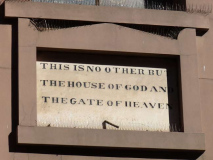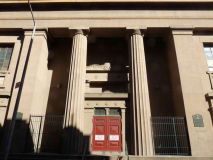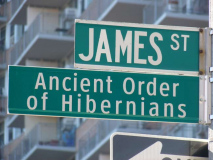The area of Manhattan east of City Hall and between the Manhattan and Brooklyn Bridge underwent drastic changes in the 20th Century…

Most of the streets seen on this 1880s map have either been completely obliterated or at least have acquired new names. Most of them were wiped out from the 1930s through the 1960s by the construction of the Alfred Smith Houses (the “Happy Warrior” NYS Governor lived as a boy in the neighborhood and a building in which he lived on Oliver Street still stands) and by the construction of the new NYPD Headquarters just east of City Hall. The street called New Bowery here is now called St. James Place.
The street I’m concentrating on today, James Street, once ran a full 7 blocks from Park Row southeast to South Street (including James Slip between Cherry and South). Today, only the short piece from St. James Place to Madison remains (marked in red) , and seemingly, that piece was spared to protect what was likely James Street’s most important building.
St. James Church is the second oldest building associated with the Roman Catholic Church in NYC. (Old St. Patrick’s Cathedral, Mott and Price Streets, built in 1810, precedes it.) The fieldstone, Doric-columned Greek Revival building was begun in 1835 and completed in 1837; and though it is thought to be a design of famed architect Minard Lefever there is no evidence to support the claim. A domed cupola above the sanctuary was removed decades ago.
The organization that runs the St. Patrick’s Day Parade in NYC, the Ancient Order of Hibernians, had its origin here at St. James Church in 1838.
In 1836, the year the church opened, the American branch of the Ancient Order of Hibernians was founded in its basement, in response to much anti-Irish and anti-Catholic sentiment in the city, including a nearby church called St. Mary’s on Grand Street being burnt to the ground. In 1983, the A.O.H. funded the restoration of the building after city officials ordered it closed down due to fear of the roof collapsing, and saved it from being demolished by 1986. Alfred E. Smith, former Governor of New York State and the first Catholic to run for President, was an altar boy here as a child. In the 1880s, he described the church as the “leading Catholic parish in New York, not excepting the cathedral itself.” In 2007, work began to be done to restore the 1889 organ. Right Here NYC
The AOH lobbied to save the church after its roof collapsed in 1983. St. James also survived a destructive fire on 1/11/2011.
The church bears a plaque honoring Padre Felix Varela Morales (1788-1853), a philosopher, patriot, educator and abolitionist as well as a proponent of Cuban independence form Spain. Though elected to the Spanish legislature in 1821, he was forced to flee Spain in 1823 after being accused of treason. Establishing himself at St. James, he dedicated himself to social reform and was a constant champion for the civil rights of immigrants here for his remaining years.
The fence in front of the parking lot next to St. James honors Pfc. Frank Vallone of the Marines, who was killed in Vietnam in 1968.
Looking southeast on James Street toward the Al Smith Houses. The spirit of Smith hovers over the neighborhood, in which he grew up.
St. James Elementary School was established in 1854 at the corner of James Street and what is now St. James Place. Until its merger with St. Joseph School and subsequent move to nearby #1 Monroe Street in 2010, it was proud of the future Governor’s attendance there as a kid — it still marks the occasion on its front door. Soon after Smith’s death, New Bowery was renamed, in 1947, for the parish and school he attended as a youth. In 2010, the Church of the Transfiguration School moved into the building. Located at 25 Mott Street, it, too, is among the oldest Roman Catholic churches in the city, though it has been in the church building, constructed in 1801, only since 1853.
The lowest house number on James Street is here at #22. Houses with lower numbers were eliminated when the portion of James Street between Park Row and St. James Place was eliminated to make way for the Chatham Green Houses.
2/27/14






